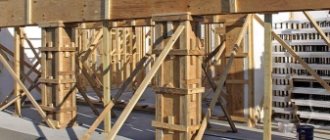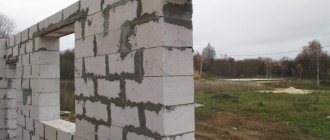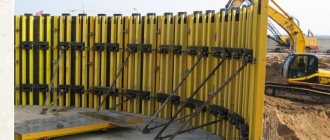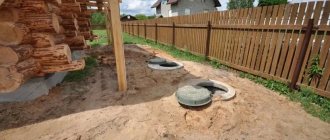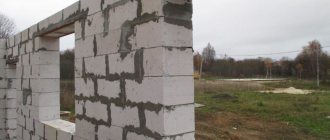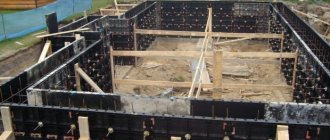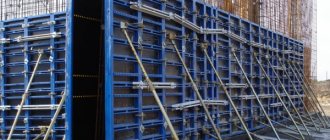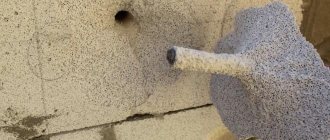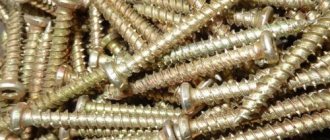- 1 Embed element
- 2 Scope of application
- 3 Types of installation 3.1 Through
- 3.2 Blind 3.2.1 Filled
- 3.2.2 Anchor
Embedded parts are used for the reconstruction of finished monolithic surfaces (when the concrete has already been poured and dried). Embedded structures can be used when modernizing, strengthening a building, or refining some part of it. The use of parts requires additional tools: a drilling/pneumatic tool for making holes on the surface. You will need a drill, a drill, which must correspond to the correct size and diameter of the desired holes.
Types of installation
There are two main types of installation: through/blind.
Return to contents
Through
It is used when a hole can be drilled in a monolith from both sides. Please note that the hole will be visible from the front side of the surface, this may spoil its appearance. The element looks like two plates with an attached rod. The rods are attached (by welding) to the plates. Bolts/studs/similar tools can be used as rods. The shape of the plate can also vary, taking the form of a hook, ring, or other configuration.
Return to contents
Blind
Use when the monolith can only be drilled on one side (when you need to preserve the appearance of the monolith). The element (similar to the first type) consists of a plate and a rod. Difference: one-sided thread on the rods. A blind bookmark is divided into the following types:
Return to contents
Jellied
It is also called embedded bonding. The installation proceeds as follows:
- a hole is made in the concrete;
- filled with cementitious mortar;
- then they are engaged in installing the rods;
- after installation, the cementing solution is distributed over the parts;
- the parts are welded.
Almost any material can be used as a cementitious solution. You can create it yourself from ordinary cement, add polymers or epoxy glue.
Return to contents
Anchor
Operating principle of the anchor: 1 – hole;
2 – cone-shaped rod; 3 – anchor tube; 4 – nut; 5 - plate. It differs from the previous method in cost and installation speed, and technological simplicity. Instead of plates, an anchor is used (a mechanism that securely fastens parts in monolithic blocks).
- the anchor is made in the form of a pipe, the diameter of which must match the concrete one;
- a rod is inserted into it (there is a thread on one of the ends);
- the anchor with the tube inside begins to be placed in the hole (rotating it, fixing it securely).
Return to contents
Scope and specificity of application
Embedded structures in concrete are used in the installation of various buildings and structures. In the construction of swimming pools, highways and highways, bridges and stairs, reinforcement of buildings. Such fasteners have a wide range of applications. Typically, embedded parts are installed in concrete at the time of pouring mortar or installing surfaces. The structure is welded to the desired installation and then filled with concrete.
When constructing certain structures, it is sometimes necessary to seal the embeds; for this purpose, primer PCI Epoxigrund 390 is used - a two-component epoxy primer composition for absorbable and non-absorbable surfaces. After applying the composition, sprinkle with quartz sand fractions of 0.3-0.8 mm and after 8 hours caulk the groove. Then coat everything with PCI Durapox NT Plus, a special two-component epoxy mixture. To prepare the composition, the hardener and main components are thoroughly mixed. The caulking of the embedded structure is done with a metal spatula.
Recommendations
You can entrust the concrete embedded part, or rather its installation, to a construction team. For a set price (you should check it on the website or get information by phone), the craftsmen will make the desired design with details quickly and efficiently. If you decide to install embedded structures yourself, use some tips:
- Before purchasing anchors (anchor bolts), ask the seller for documents for the products and look at the steel profile. For their manufacture, periodic profile steel A-1, A-2, A-3 should be used. They are considered the most stable and high quality.
- The steel grade for anchor rods should be selected depending on operational standards and the scope of future work. Consult with the seller before purchasing, be sure to indicate to him the purpose of your purchase.
- For greater efficiency, use protective sleeves. They can be purchased at any hardware store or ordered from the manufacturer if the size of the embedded parts is non-standard.
- Consider the grade of concrete before purchasing materials.
- The embedded part must be of high quality, without cracks or breaks.
Return to contents
What it is?
Metal parts embedded in concrete and used to strengthen the concrete structure and attach subsequent ones to them are called embedded elements. They are installed before installation work begins. If necessary, they are installed in a ready-made dry concrete monolith. To do this, use a drill, drills of various sizes in accordance with the required hole diameter. There are several types of installation of embedded installations. The choice of one or the other depends on the purpose of the fastening, the ability to mount it, taking into account the load that will be distributed to the embedded parts.
And also when carrying out work, take into account:
- concrete strength;
- brand of material;
- strength of steel.
At the end of the installation process, control checks of the parts are performed.
Mortgage structures must have good strength without cracks, breaks or any damage. After final drying or installation of already dry concrete, the reliability of the embedded fastenings must be checked. To perform this type of work, it is recommended to contact qualified specialists.
INSTALLATION RECOMMENDATIONS
works on individual orders: in order for us to calculate the cost and production time of the required number of embedded parts, send the technical specifications by email
We will help you determine what grade of steel is needed during the construction of your facility, tell you the difference between installing embedded parts weighing up to 4 kg and installing embedded parts weighing up to 20 kg, and also advise on all your questions.
In addition, we are always ready to help you not only choose embedded parts, but also deal with their installation. Here is an example of some simple recommendations:
The type of adhesive material is indicated in the drawings of the embedded parts and can be made independently in a special glue mixer; The types of degreasing solutions are also indicated in the documents; The permissible degree of surface roughness before treating it with an anti-corrosion agent is calculated in accordance with GOST 2789-73 “Surface roughness. Parameters and characteristics”; Use abrasive blasting or sandblasting to clean surfaces from scale; If rust appears, remove it with a primer or etching agent.
EMBODIED PARTS
In the manufacture of parts, steel grades 09G2S and St3 are used.
The type of steel used depends on the structure in which it will be used. For example, 09G2S steel is used in construction at low temperatures; St3 steel is the most common type of steel for the manufacture of embedded parts due to its increased mechanical properties. In addition, in the production of embedded parts, it uses such modern technologies as robotic welding and laser for countersinking and cutting, which allows increasing productivity and reducing order completion times, while reducing the selling price of the product without loss of quality. All parts sold comply with GOST standards and also undergo additional tests in destructive testing laboratories.
Home > Articles > Technology for installing embedded parts
Monday, June 27, 2016
Embedded parts are special construction products made from different types of steel and consisting of rods and plates. They serve to increase the strength, reliability and safety of the structure being built, which is especially important in the construction of tall and large structures. Also, the demand for such metal elements is growing due to the emergence of new technologies in the construction industry.
Types and types of such elements
Depending on the type of material used for their manufacture, embedded products are made of steel of different sections (circle, sheet, strip, angle and channel). Depending on the type of installation, they are divided into: open and closed parts. The type of anchor rod structure they have may also differ. There are parallel, perpendicular, inclined and mixed rod arrangements. Anchor rods are available with or without pre-threaded threads.
Installation of embedded metal elements is required in the following cases:
- during the construction of buildings or structures to improve their quality and reliability;
- during reconstruction or improvement of an already finished structure.
Embedded metal products can be attached to the concrete surface using conventional anchor bolts, anchor bolts with a special overlay, simple rod anchors or rod anchors with an additional fastening element (hook, ring, plate).
Technology of installation of embedded parts
Embedded parts are attached to surfaces made of different materials (concrete, stone or reinforced concrete) for subsequent attachment of structures of various types to them. They are installed in pre-prepared holes or welded to reinforcement and then filled with concrete.
- First, a detailed plan for the construction work is thought out and drawn up, which also necessarily indicates all the parts used, the exact dimensions of these parts and the entire structure, and the type of their installation. Such a plan may include drawings and calculation formulas.
- Before starting the installation of all elements, it is imperative to clean all surfaces, holes and rods from rust and contaminants. Then the surfaces are primed and thoroughly dried for several hours.
- The embedded product is being fastened.
- To prevent corrosion of embedded products, several layers of special anti-corrosion material are applied to them. After applying each layer of the substance, the surface is dried.
Installation types
The type of installation of an embedded metal part depends on the type of monolithic material. Through installation is used when it is possible to make a through hole in the material. In this case, a metal rod of the embedded element is inserted into the hole and welded to two steel plates.
Blind installation uses parts consisting of several or one rod and one plate. They are attached only on one side. Blind installation comes in two varieties: poured and anchored. During poured installation, all holes are filled with glue or, if subsequent welding to a part of any metal structure is planned, with cement. Then a layer of glue or cement is applied to the surface of the structure and the steel part is secured in the desired position. When anchoring, parts are secured using special anchors.
Installation recommendations
- When installing embedded products, it is advisable to use anchor bolts and rods made of steel classes A-I and A-III.
- Metal embedded parts are made of steel of different chemical compositions (grade). The choice of a part made of a certain grade of steel depends on the future operating conditions of the structure.
- You can make the adhesive for assembling parts yourself in a special glue mixer.
- To degrease the surfaces of steel parts, solutions prepared from soda and trisodium phosphate are used.
- The permissible degree of surface roughness before treating it with an anti-corrosion agent: from 40 to 60 microns.
- If it is necessary to clean the surface from scale, it is preferable to use abrasive blasting or sandblasting.
- It is better to remove rust with a special etching agent (paste) or a rust converter (primer).
What is a mortgage
Embedded parts are metal elements used to connect reinforced concrete structures. Fastening of embedded parts is carried out in structures made of concrete and reinforced concrete.
Built-in parts are divided into two types - they can be open and closed. This depends on the position of the anchor rods relative to the flat element.
Installation of embedded parts is relevant in construction and during the construction of:
- Bridge structures;
- Enclosing structures;
- Hangarov;
- Facade elements;
- Supporting structures and floors;
- Stairs;
- Wells for elevators.
These items are supplied unpainted or coated. The coating is present on those parts that will remain outside the concrete panel.
Installation locations, use of embedded elements
The main operations of building a foundation and other enclosing structures are:
- installation of service and observation platforms
- installation of door/window blocks
- production of crane tracks
- joining of enclosing/supporting structures
- assembly of elevator shafts, tunnels
- installation of grilles, blinds
- construction of road barriers
- production of berths, parking lots, hydraulic structures
- arrangement of internal, fire escapes, porches
- installation of towers, columns, masts
- fastening of equipment, tanks, heat exchangers
- facade cladding
Kinds
The parts differ in several ways. A division is carried out according to the load carried by embedded elements for reinforced concrete structures. There are products with the following anchors:
- standard;
- tilted;
- overlapped.
The purpose of the elements is to create a strong and reliable connection of monolithic prefabricated structures and parts of technological channels.
The strength characteristics of a concrete base can be increased by reinforcing it with meshes or metal rods or rods. These parts belong to closed-type embedded structures. Classified according to the following characteristics:
- According to the type of rod anchor: round or corrugated reinforcement; straight or curved; with or without threaded connection.
- According to the method of performing installation work: ZDA, involves reinforcement studs on two conductors; ZDF assumes a pipeline with a flange.
All embedded elements comply with GOST 10922-90. It is important to ensure the reliability of their design in terms of load transfer. For the construction of the foundation of a permanent structure, an anchor rod or A-III - A-II class reinforcement with a cross-section of 0.8-2.5 cm is recommended. The choice depends on the climatic conditions of the area. When the temperature drops 30 degrees Celsius below zero, you need to buy VSt3ps6 steel plates. They will be able to withstand difficult conditions without losing their technical properties.
Products can be protected from the harmful effects of corrosion by galvanization, galvanizing, and painting. Insignificant loads on the reinforced concrete structure allow the installation of stamped 3D. Increased shear and tear forces force the use of anchor rods welded to the plates.
Elements are distinguished according to the type of planes on which use is permitted:
- horizontal;
- vertical;
- combined.
In horizontal direction it is allowed to use:
- "chair". Recommended as a rivet in horizontal planes. Used when pouring concrete foundation structures, installing concrete flooring and floor slabs. Involves a protective coating with a thickness of 15-40 mm. Calculated for metal products 4-18 mm. The main advantage: a large number of points of contact with wooden formwork;
High chair
- "stand". The item is universal. Recommended for metal frames with a cross-section of 6-25 mm. Protective layer - 15-25 mm;
Rack
- “multi-story rack.” Reliable replacement for all types. The rigidity of the design allows it to withstand the strongest upper loads. By superimposing individual parts at a distance of 5 mm in height, you can make a reliable case. Protective coating - from 2 cm;
- PVC pipe;
- plugs and stoppers;
- ceiling support.
In the vertical plane, an “asterisk” fits. Purpose: formation of a protective surface of 15-50 mm. Used for metal rods with a cross section of 0.4-3.2 cm.
Star
Combined embedded products are a universal option used for vertical and horizontal surfaces. Protective ball - 10-40 mm. The fastening is carried out on a metal frame with a cross-section of 5-12 mm.
Combined
Connection methods
Anchor rods of various types of fastening of the 1.400-6/76 series are chosen for through installation of prefabricated and monolithic structures, elevator wells, strengthening of masonry, foundations, supports, floors. They reliably fix individual segments, technological channels, and impart strength.
The base is installed on concrete, the anchors are connected by overlap welding or in t-welds under a flux layer in accordance with GOST 14098-91 using automatic machines for a gas environment. The arc method is effective for countersinking holes. It is used provided that the plate thickness is 0.75% of the anchor diameter. Welding by hand welding according to GOST is not permissible.
The embedded parts MN 501-522 of groups 3, 5, 6 are overlapped by manual arc welding according to CH393-78. For the rest, except for products with vibration loads, in addition they use the relief-point hot method in accordance with GOST 19292-73, type 15.
For structures of group 2 (frames and formwork), anchor rods are not welded to the base, unless the customer, under the contract, requires the manufacture of a monolith. Products of group 6 are manufactured separately at the factory and supplied complete with rings and hooks.
When fastening fragments along the edges and under light loads, welding of embedded parts is ineffective. For this purpose, stamped blanks marked MH from rolled strip produced by cold pressing are suitable. Monolithic plates and anchors are cut out with a stamp from one strip and then folded on a special machine.
Preparatory stage
Professional builders claim that the stability of sliding gates and their long service life directly depend on a reliable and durable concrete base. It must be constructed in accordance with all standards, meeting technological requirements.
A properly constructed foundation can ensure uninterrupted and long-term operation of all mechanisms. A heavier design must be matched by a more powerful “cushion”.
First, the land plot is marked according to the plan.
To construct a foundation for a 4-meter-long sliding gate, a platform the size of half the opening of such a portal is required. Accordingly, for a four-meter opening, it is necessary to provide an area for the base approximately 2 m long. Its width is usually made 0.5 m. An area for the foundation pit is marked on the inside of the gate away from the passage.
INSTALLATION TYPES
Installation of embedded parts is divided into 2 types: through and blind.
Through installation of embedded parts is used when it is possible to make a through hole in the material. A metal rod of the embedded element is placed in the hole, which is welded to two steel plates. With blind installation, parts are attached only on one side. All holes are filled with glue or cement and the steel part is secured (filled type of blind installation); with the anchor type of blind installation, the parts are secured using special anchors.

